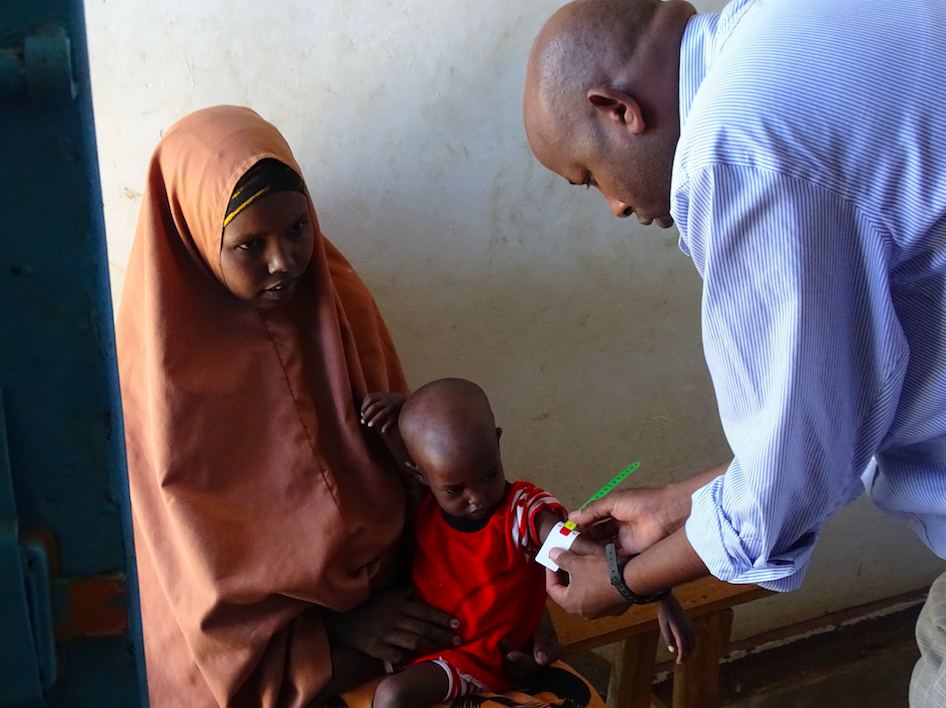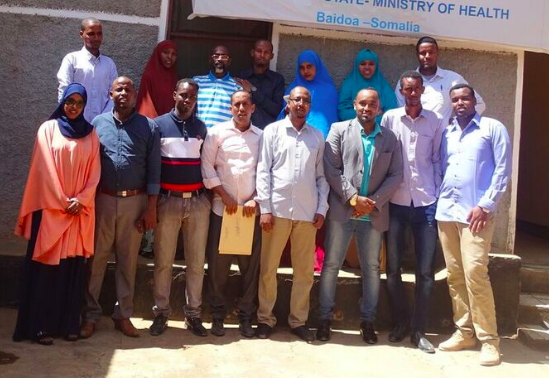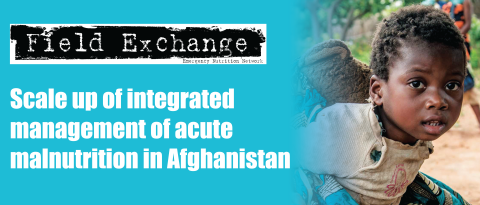Health systems strengthening in fragile contexts: A partnership model in South West State, Somalia
By Kevin Paul Mackey and Sirya Ezekiel Kiptum
Kevin Mackey is the Programme Development and Quality Assurance Director for World Vision Somalia, where he has held a number of operational, programmatic and quality assurance roles over the last ten years. Prior to this he participated in the design, implementation and monitoring of projects across the entire spectrum of humanitarian response.
Sirya Ezekiel Kiptum is the Health and Nutrition Sector Lead for World Vision Somalia. He is a public health specialist with over 15 years’ experience of managing health and nutrition programmes in development and fragile contexts, including in Kenya, Uganda, South Sudan, Ethiopia and Somalia.
Location: Somalia
What we know: Delivery of health services by the Ministry of Health (MoH) in Somalia is heavily dependent on international and local non-governmental organisations and United Nations agencies.
What this article adds: In 2015 World Vision (WV), funded by Global Affairs Canada, implemented a new, two-year model of partnership for the delivery of health and nutrition services directly through the MoH for South West State (SWS). This focused on strengthening human resources for health; health financing and resource mobilisation; governance and leadership (management); supplies of medical products; and quality service delivery. A WV/MoH-SWS memorandum of understanding (MoU) guided the process and government capacity, categorised within a WV partnership framework. A task force oversaw developments. The single-donor pilot project created 54 new staff positions in the MoH-SWS; this has grown to 233 staff with multiple donors and expanded facility/health post/mobile clinic coverage. Key success factors included building community trust in government-led services, strengthened medical supplies management, development of a capacity-development plan with regular mentoring and follow-up that included financial systems and controls, and support to the regional health service. The MoH has demonstrated significant progress and signs of leadership through this support; external resources and capacity are still needed to meet health and nutrition needs. Emergency, short-term funding continues to dominate; longer-term (development) funding streams are needed to sustain health systems strengthening in fragile contexts.
Background
Since the collapse of the Siad Barre-led government over 25 years ago, the health sector in Somalia has faced almost total collapse. Thus, health services are delivered predominantly through local non-governmental organisations (LNGOs), supported by international non-governmental organisations (INGOs) and United Nations (UN) agencies, with the Ministry of Health (MoH) providing leadership and strategic direction to local health facilities. However, the MoH is very weak in most states/districts in Somalia and non-existent in Al Shabaab-controlled areas due to lack of access.
Since 2006 World Vision (WV) has supported the development of the National Tuberculosis Programme (NTP), helping it deliver on its mandate to develop policy and monitor tuberculosis programming in Somaliland, Puntland and southern Somalia. Drawing on lessons learned from such capacity-development efforts with government entities and other civil society actors, WV expanded the scope of its partnering efforts in 2011, putting in place policies and operational structures and developing methodologies to deepen engagement with LNGO partners in southern Somalia. The emerging governance environment created opportunities to leverage this experience to modify the existing LNGO partnering approach to work with the nascent MoH for South West State (SWS). In May 2015 WV, with the support of the humanitarian fund of Global Affairs Canada (GAC), undertook a one-year pilot of a new model of partnership for the delivery of health and nutrition services directly through the MoH – the first time this approach had been used in the state. Funding from the GAC was then renewed annually, based on performance. The partnership focused on strengthening the following pillars of the health system: human resource for health; health financing and resource mobilisation; governance and leadership (management); supplies of medical products; and quality service delivery. This article describes the model of partnership, noting key lessons learned in the process.
 Partnering process
Partnering process
WV’s previous partnering experience showed that concentrating only on sector-specific capacity-building was not sufficient to develop competent, professional organisations. Rather, a holistic approach is required to professionalise all levels of an institution. WV’s approach to partnership aims to tailor specific capacity-building plans to the strengths and weaknesses of implementing partners. It is not a ‘one-size-fits-all approach’, but an interactive, flexible process that relies on field-based expatriate technical staff developing mentoring relationships with partners and heavy emphasis on ‘on-the-job’ experiential learning. The emphasis on delivering non-specified health services ensures that the partnership is practical and flexible, modifying project designs/budgets to address emergent challenges that arise.
WV approached the MoH-SWS about establishing a memorandum of understanding (MoU) that would guide a partnership process for strengthened health service delivery. The nascent MoH-SWS was labelled “emergent” as per the WV partner categorisation system1 as it lacked systems and processes. Emergent status meant that the MoH-SWS was only allowed to directly manage a small quantity of financial resources. However, emergent status also ensured close technical support would be provided to increase capacity across a range of skillsets, including financial, administrative and human resource management. At the time the MoH-SWS had only three staff: the Minister of Health, the Deputy Minister of Health and the Director General of Health. WV and MoH-SWS co-created the MoU, drawing on MoUs WV had with other state entities in Somalia. The MoU delineated the different roles and responsibilities in key areas of partnership, including: financial support; supplies provision (pharmaceuticals and medical equipment); recruitment of staff (human resource for health); and technical support (capacity development).
Building trust
After 25 years of civil conflict, communities were not accustomed to the government undertaking health service provision and were suspicious of the capacity of the state to provide unbiased health services. WV brokered meetings between community management committees and the MoH-SWS to help foster mutual trust. The initial meetings were tense; however, as transparent processes were negotiated for the allocation of duties and resources, the facility-level management committees warmed to the idea of the state as a viable actor in the provision of health services.
Human resources
The pilot project created 54 new staff positions within the MoH-SWS with two-year funding under the GAC grant via WV Somalia (one-year pilot funding plus one-year scale-up). WV introduced the
MoH-SWS management to key standards and norms, encouraging the use of World Health Organization (WHO) recommendations, current UNICEF practices and the Essential Package of Health Services (EPHS) guidelines as a means of developing an aligned health and nutrition management structure. Once staffing structures were finalised, incentive rates for skilled, semi-skilled and non-skilled facility-level staff members were agreed2. WV, MoH-SWS and the facility-level health committee ‘task forces’ (tasked with overseeing development within their local area) agreed to a management structure, respectful of the local management committees’ desire to take an active role in the day-to-day running of the facility. The community management committee leadership role was further recognised by allowing the committee to forward applications from qualified community members, who were immediately shortlisted for the recruitment process. It was agreed that non-skilled staff members were to be recruited directly by the local facility-level health committee task force, while skilled and semi-skilled staff would be recruited through a rigorous and transparent process. Non-skilled staff categories included guards, community health workers (CHWs) and mobilisers and cleaners. The negotiated arrangement promoted buy-in from suspicious community management committees, who were fearful of losing control of their community asset, and ensured that the most important roles – mainly the skilled and semi-skilled staff members – would be recruited through a competitive recruitment process.
With the advice of key government officials and guidance from the WV Human Resource Department, the team defined a recruitment process. The Governor of Bay Region and District Commissioner of Baidoa were enlisted to help manage community expectations and offer advice on how to create a transparent process which was acceptable to the community. Skilled and semi-skilled employment was rare; thus competition for such positions was high and pressure on MoH-SWS government officials from other powerful community stakeholders to favour candidates was strongly felt. Over 436 applications were received for the 54 positions.
As well as supporting recruitment, WV developed a payroll system and payment mechanism by which facility-level staff members received a direct transfer from WV either to their personal account or directly to them through mobile money transfer at the end of each month, following accurate submission of timesheets by the MoH-SWS. Developing these shared processes helped to mentor the MoH-SWS on the importance of accounting for staff working hours, promoting both upwards accountability to donors and downwards accountability to the community management task force committees.
Facilities, supplies and equipment
The MoH-SWS was encouraged to adopt WHO minimum standards for the supply of maternal child health (MCH) facilities, including a list of standard supplies and drugs. WV took responsibility for procurement of the medical supplies and equipment for the project to ensure all drugs were procured from certified suppliers. The MoH should work with the certified suppliers to ensure quality of drugs procured and prevent substandard counterfeit drugs. Standard operating procedures (SOPs) were established to deal with requisitions, reorder levels and relevant documentation and accountability on consumption/utilisation of consumables. WV technical staff also provided training to the new-hire facility-level MoH-SWS staff members on the utilisation of medical equipment.
Health and nutrition technical support
WV and the MoH-SWS agreed on a capacity-development plan anchored in regular structured workshops followed by close mentoring and on-the-job training. Although many of the new-hire staff members had previous health sector experience, gaps became apparent and tailored capacity development to tackle areas of weakness was developed for specific facilities and teams. One example was the Core Infection Prevention and Control (IPC) standards, which was a new concept for many staff. A formal workshop was held in which the process was outlined and staff members were trained on facility-level procedures. The training was so well received that teams immediately requested an autoclave to sterilise delivery equipment to reduce cross-infection. Savings were reallocated within the project to purchase the equipment to support staff members’ desire to improve practice at the facility level. Staff were encouraged that trainings and their follow-up request could result in actions by the MoH-SWS to improve the quality of their work. This helped enhance the perception of the MoH-SWS as a responsive management mechanism. Technical trainings were provided on integrated management of childhood illness (IMCI), integrated community case management (iCCM), communicable disease management, basic emergency obstetric and neonatal care (BEmONC), integrated management of acute malnutrition (IMAM), health facility commodity supply and supportive supervision. The MoH-SWS Director General and WV’s Health and Nutrition Technical Specialist, along with other senior staff, provided technical support to the field-based teams, including regular joint supportive supervision, during which clinic staff were supported in identifying solutions to the gaps, needs and challenges. Particular challenges identified were the lack of supplies of therapeutic foods, sharing of therapeutic foods due to lack of food at home, poor access to hard-to-reach villages and nutrition services, and general access and insecurity challenges.
Finance, administration and supply chain technical support
Prior to the pilot project the MoH-SWS had very little experience in internal financial controls and even less in developing accountability mechanisms. WV’s Finance and Support Service Manager provided hands-on support to co-create payroll and procurement documentation and procedures with the MoH-SWS. Sample formats for purchase requisition forms, local purchase orders, goods received notes and request letters were provided to MoH-SWS to help staff develop their own documentation. Guidance was provided on how to develop simple contracts for vehicle hire and develop and manage logbooks, and create labour distribution reports and timesheets for newly hired facility-level staff members.
The mentorship approach used for finance and support services in the pilot was viewed as a great success. It was not only a powerful risk management mechanism, allowing expatriate staff members to quickly identify capacity gaps, but the trust built through close association allowed field-level teams to co-create solutions. For example, after the first quarter of the pilot phase, it became apparent that the three-person MoH could not manage the level of technical rigor and attention to detail required to meet stringent financial accountability standards. In response, budget was reallocated to fund the position of Administration Officer in the MoH-SWS, creating a dedicated focal point to deal with all administrative and financial issues and someone whom WV’s technical specialist could mentor and support. The inclusion of the Administration Officer enhanced the capacity of the MoH-SWS to manage donor resources, thereby increasing the amount of financial resources directly managed by the Ministry (detailed financial information is not available from the Ministry). MoH-SWS professionalism improved and financial systems were established that were aligned with international accounting practices.
 Support to regional health structure
Support to regional health structure
While the initial phase focused on support for facility-level implementation, it became apparent that the district health system needed to be strengthened to support all health actors in Baidoa district. Experience during the pilot phase identified that the District Medical Officer for Health role was too wide-ranging, covering issues of health and nutrition and water, sanitation and hygiene (WASH), and was not able to provide adequate support to primary healthcare facilities and outreach teams. After reviewing the provisional district structure, WV and MoH-SWS agreed to allocate funding to support a new Primary Health Care (PHC) Supervisor role. PHC Supervisors monitor and provide training at facility level to MCH staff members. In addition, a gap in information management was identified. While the MoH had terms of references (ToRs) for information management roles, these roles were vacant due to lack of funds. In response, budget allocation was made (from the GAC fund, via WV Somalia) and staff were recruited. These new positions decreased the workload of the Director General, allowing him to address other more strategic issues related to the management of the MoH. At facility level, Team Leaders were assigned additional core responsibilities, including decision-making on activity planning, resupply, reorders, mobile airtime purchase and referral of patients.
Expanded partnership
The initial one-year partnership with MoH-SWS has since been scaled up (also with GAC funding, as well as resources from the Office for United States Disaster Assistance (OFDA) in year two) from two health facilities, two mobiles teams and 54 new staff to eight health facilities, 26 internally displaced persons (IDP) camp-level health posts and four mobile clinics providing basic health and nutrition services to IDP, returnees and host community members. A total of 233 MoH staff are now employed across the state, a dramatic increase from the initial three in 2015. GAC funds are channelled to the MoH via WV Somalia to pay salaries each month, based on timesheets submitted. In addition, MoH and WV leveraged this partnership to scale up and respond to recent acute water diarrhoea/cholera response. District rapid response teams (RRTs) were deployed to respond quickly to rumours, investigate and mount an aggressive cholera response, providing curative services, referral of severe cases to the cholera treatment centres/cholera treatment units and community mobilisation – and with good results, as cholera was contained in most SWS areas. Following the initial partnership with WV, MoH-SWS has used the MoU format to sign partnership agreements with four other LNGOs and other INGOs have leveraged the strengthened MoH-SWS to achieve their emergency response objectives, especially in inaccessible areas.
Conclusion and the way forward
To build a sustainable health sector, government, NGOs and private actors must have the resources and capacity to fulfill their respective roles. Our long-term vision is of an agile, robust MoH taking a leading role, supported by partners. To build this capacity, WV employs a holistic approach, focusing not only on the technical capacity of sector entities to deliver, but also on their governance and management capability. Through this partnership, MoH-SWS gained practical experience managing health facilities, was exposed to international best practice and strengthened its capacity to professionally monitor other health actors, enhancing quality control for the health system. A recent WV capacity assessment resulted in the partnership with the MoH being categorised as ‘growing’; the hope is that in a few years the partnership will reach ‘maturity’. The MoH now chairs the cluster meetings, demonstrating good leadership. Much of the success of the past two years can be attributed to the recruitment process, which helped build the credibility of the MoH-SWS and resulted in qualified and experienced staff being recruited to the MCH facilities and mobile teams.
Finally, the partnership approach created conditions in which trust can be fostered between the community and the state. For the state-building project to be a success in Somalia, state institutions must have know-how and be perceived as credible in the eyes of the communities to which they are accountable to exercise their mandates effectively. This approach has not only succeeded in bringing much-needed health services to vulnerable communities but has bolstered the reputation of the state as a credible, representative actor in the provision of basic services. The Government of Somalia still has very limited resources, which are mainly used to support security, so external actors will have a role to play for some time; however, due to this pilot and scale-up, other actors are now willing to fund the MoH directly (including Save the Children International, the International Organization on Migration, Italian Cooperation and UNICEF). Funding avenues in Somalia remain dependent on short-term (nine to 12 months) and emergency responses; further advocacy to donors that provide longer (development) funding streams with interest in health systems strengthening in fragile contexts, like SWS institutions, is required.
For more information, contact Ezekiel Sirya.
Endnotes
1The development stages of WV partnerships are categorised as: (1) embryonic; (2) emerging or nascent; (3) growing; (4) well developed; (5) mature.
2Incentive rates varied per cadre and qualification: CHWs $50, cleaners and guards $200, auxiliary nurses and nutrition assistants $300, qualified nurses and midwives $480, PHC supervisor $600 (all monthly).


